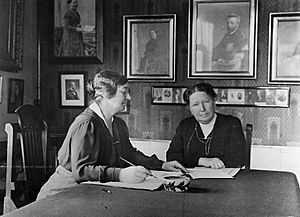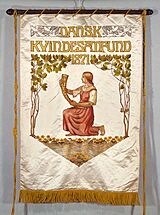Danish Women's Society facts for kids
The Danish Women's Society (DWS) is the oldest organization in Denmark that works for women's rights. In Danish, it is called Dansk Kvindesamfund. It was started in 1871 by the activist Matilde Bajer and her husband, Fredrik Bajer. Fredrik was a member of Denmark's parliament and won the Nobel Peace Prize in 1908.
The DWS fights for the rights of all women, girls, and the LGBTQA community. The group believes in fairness and equality for everyone, no matter their background. It also publishes the world's oldest magazine about women's issues, called Kvinden & Samfundet (Woman and Society), which started in 1885. The DWS works with similar groups around the world, including the International Alliance of Women.
Contents
History
The Danish Women's Society was created to give organized support to women, especially those in the middle class. From the very beginning, it was not connected to any political party. The group's main goal was to improve the lives of women by helping them get an education and become more independent.
The Early Years (1871–1906)
When the DWS first started, one of its biggest goals was to improve education for women.
- In 1872, it opened a business school for women.
- In 1874, it started a Sunday school for women who worked.
- In 1895, it created an art school for women.
Another important early goal was to change the law so that married women could control their own money.
Getting the Vote (1906–1940)
Starting in 1906, the DWS focused on getting women the right to vote. This hard work paid off in 1915 when the Danish constitution was changed. Women were finally given the right to vote in national elections for the parliament, called the Rigsdag.
After this victory, the group worked for equal pay and better job opportunities. Their efforts led to new laws. In 1919, a law was passed to improve the salaries of women working for the government. In 1921, another law gave women and men equal access to government jobs.
During this time, the DWS also worked to help pregnant women. They pushed for reforms so that mothers would have the support they needed to raise their children. This led to the creation of help centers for mothers all over Denmark.
World War II and After (1940–1950)
During the German occupation of Denmark in World War II, the DWS helped create Danske Kvinders Beredskab. This was a group of women prepared for civil defense. They provided medical care and helped with evacuations during bombing raids. The DWS also focused on helping women who had lost their jobs.
After the war, the group noticed that very few women were being elected to the Danish Parliament, known as the Folketing. They worked to encourage more women to get involved in politics. They also supported the idea of women becoming priests, which became legal in 1947.
Focus on Social Issues (1950–1970)
In the 1950s and 1960s, the DWS focused on social policies. They worked to support single mothers and women who stayed at home to raise families. The group also helped women get training to return to work after taking time off. Another major goal was to get more kindergartens built so that children had a safe place to go while their parents worked.
Policies
LGBTQA Rights
The Danish Women's Society is a strong supporter of LGBTQA rights. The group has said that it takes homophobia (negative feelings toward gay people) and transphobia (negative feelings toward transgender people) very seriously.
The DWS states, "we support all initiatives that promote the rights of gay and transgender people." They see the LGBTQA movement as a close partner in the fight for equality.
Presidents
Many people have led the Danish Women's Society over its long history. Here are some of them:
- Matilde Bajer (1871)
- Severine Casse (1871–1872)
- Caroline Testman (1872–1883)
- Marie Rovsing (1883–1887)
- Kirstine Frederiksen (1887–1894)
- Jutta Bojsen-Møller (1894–1910)
- Marie Riising Rasmussen (1910–1912)
- Astrid Stampe Feddersen (1912–1918)
- Julie Arenholt (1918–1921)
- Gyrithe Lemche (1921–1922)
- Karen Hessel (1922–1924)
- Elisa Petersen (1924–1931)
- Marie Hjelmer (1931–1936)
- Edel Saunte (1936–1941)
- Andrea Hedegaard (1941–1943)
- Ingrid Larsen (1943–1947)
- Margrethe Petersen (1947–1948)
- Erna Sørensen (1948–1951)
- Hanne Budtz (1951–1956)
- Karen Rasmussen (1956–1958)
- Lis Groes (1958–1964)
- Inger Wilfred Jensen (1963–1966)
- Nathalie Lind (1966–1968)
- Eva Hemmer Hansen (1968–1971)
- Grete Munk (1971–1974)
- Grethe Fenger Møller (1974–1981)
- Jytte Thorbek (1981–1983)
- Helle Jarlmose (1983–1987)
- Lene Pind (1987–1991)
- Benthe Stig (1991–1993)
- Brita Foged (1993–1995)
- Lenie Persson (1995–1999)
- Karen Hallberg (1999–2011)
- Lisa Holmfjord (2011–present)
See also
 In Spanish: Sociedad Danesa de Mujeres para niños
In Spanish: Sociedad Danesa de Mujeres para niños



